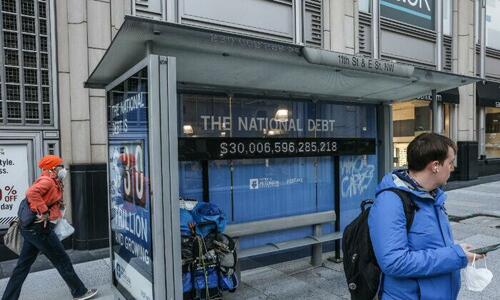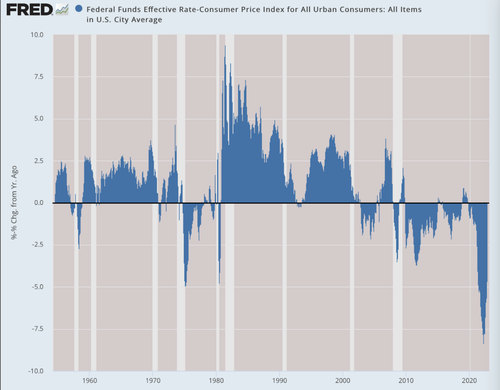The Age Of Easy Money Is Over
Authored by Jeffrey Tucker via The Epoch Times,
What began in 2008 and continued for the better part of 14 years appears finally to be coming to an end. The era of cheap money and credit is over.
It’s hard to wrap one’s brain around the implications. It will affect all of business life and personal finances. It will dramatically change financial decisions and also affect the culture. It’s going to amount to a return to good-sense, value investing, and companies that have to actually make a profit the old-fashioned way.
I’m not just talking about layoffs in Big Tech. But those are very real. Amazon is laying off 10,000 workers in management layers—which everyone in corporate America knows are the the most useless people in any business. They got puffed up beyond reasonable size completely due to seemingly infinite resources and forever rising stock valuations based on nothing but inflated reputations.
Such cutbacks are occurring in every major company that reached gargantuan size. Twitter was just the beginning because soon after Facebook (sorry, Meta) announced the same, while many other companies that lived off ad revenue on the internet are experiencing the profitability squeeze as we headed into a solid recession (it will become obvious in months that we are already there).
It also affects real estate, the residential markets of which are already freezing up. And commercial real estate in big cities is similarly affected, particularly offices that are still only half-full. Lacking a buyers’ market, prices will have to come down relative to where they are today, though they are likely to remain inflated over valuations from 2019 due to persistent inflation that is only very gradually calming down.
The huge issue today concerns the rate of return on the safest place to park and move money, namely U.S. debt. For nearly a decade and a half now, short-term interest rates have been negative. This is without precedent. It amounts to the loosest-possible monetary policy. By incentivizing capital to chase anything but safety, and discouraging savings in all forms, finance received a huge boost. But so did everything else, including crypto.
Looking back, it seems obvious that the craze for extreme risk, the who-cares attitude about the pace of business expansion, the magic-beans environment of digital tech, the claims that society has somehow managed to commoditize attention without committing resources, not to mention out-of-control government spending—all of this was propped up by zero-interest rate policies adopted after the last housing market crash.
The innovation perhaps seemed costless at the time. Ben Bernanke came up with the idea. Drive rates to zero to spare the financial system and macroeconomic environment but suppress the normal inflation that would follow through an accounting trick. The Fed would pay a higher than market rate to banks to keep their assets at the Fed, which would lock them away to keep them from creating inflationary pressure. For this great innovation, he was heralded as a genius.
What was the downside? For a while, it seemed like there was none. Savings did not fully collapse beyond their previous level simply because inflation was in check. And yet keeping money in Treasuries was no place for return. So money and capital went on a wild hunt for the whole of the 2010s, times when anything seemed possible both in finance and government. Rates were zero, homes were affordable, and credit was plentiful for everything and everyone.
Every kid could go to any college and rack up six figures of debt learning quasi-Marxist social theory, and porting that over to the workplace where high-flying fancy firms would employ them at high salaries to be clever on Slack and otherwise push woke philosophy. It was in this period that academia was flush with money and no longer had to worry about customers, so it began the great purge of conservative thinkers or anyone who disputed any aspect of the new religion.
So too it went in the corporate world, which came to dismiss old-fashioned concerns like serving customers and stockholders and instead pushed philanthropy and alignment with social and climate justice. It was this environment of infinite plenty that encouraged this simply because the possibilities seemed limitless and there seemed to be no cost at all.
It was precisely during this period of paper-fueled illusion that ESG and DEI were adopted by the best and brightest as central concerns in corporate life, and the experts at the World Economic Forum were on hand to pronounce that balancing the books is not nearly as important as signaling all the right virtues. Media backed up the craze at every step.
All of this was made possible by Bernanke’s scheme. To appreciate how radical it was, we can adjust the federal funds rate by inflation and look back to the end of World War II and see. Rates very rarely went into negative territory except in the 1970s owing to high inflation. But once that problem was fixed, rates rewarded savers and kept economic rationality at the forefront from the 1980s to 1990s. These times were denounced as cowboy capitalism but the truth is that savings were high and value investing was popular. The prosperity of those years was on a firmer footing than anything that followed.
After 2008, all bets were off. We plunged ever further into the abyss of negative rates. The Fed itself ballooned up a balance sheet as never before—effectively stuffing underperforming assets in every closet and filling up the basement too.
Fed funds 1954–2022 adjusted for inflation. (Data: Federal Reserve Economic Data [FRED], St. Louis Fed; Chart: Jeffrey A. Tucker)
It was unsustainable, obviously, and the Fed planned an escape which began in 2019. It did not last thanks to the pandemic response, which called on the Fed to do the unthinkable. It went crazier than before. This time the destination of the new money was different. Instead of cold storage, the new money flooded the streets as hot money to spend right away.
The Bernanke chicken finally came home to roost, 14 years later and following massive damage to economic structures, financial markets, time horizons, and the culture at large. Everything awful had enjoyed a vast financial subsidy: bogus corporate ideological binging, fake credentialing, fashionable socialistic philosophizing, and bad science. Bernanke’s seemingly costless policy created a world unhinged from reality.
After all these years, we now see the cost in intolerable levels of inflation. The Fed needs to put an end to it by driving up real rates above zero. That is going to require far more than what it has done so far. And to really repair the damage will require many years of restoration of balance sheets, a reshuffling of the workforce from fake to real jobs, and a return of sanity in financial markets and corporate culture.
Will Jerome Powell do it? It’s very likely. He doesn’t want his legacy to be the central banker who devastated the dollar’s value. He wants to be remembered as a Paul Volcker who made the hard choices even as the whole world was screaming at him. Wall Street today keeps hoping for some respite from the war on inflation but they are hoping against hope. Powell still has a very long way to go.
Thus does the new era of tight money begin. I can’t think of a better poetic ending to the age of excess than the disgrace of the silly man Sam Bankman-Fried and his merry band of hucksters and druggies who bamboozled the whole of the ruling class into believing that they had some kind of Midas touch to mint money to fund all the causes the hard left sees as holy. FTX died a quick and fabulous death, and with it the dreams of a fully woke pool of infinite funding.
The transition from fantasy to reality is going to be extremely painful, not just financially but psychologically for a whole generation that imagined they could live a life untethered from all norms and rules of the past. The truth is that the dollar-based world has been living a 14-year lie. That truth is going to be a hard pill to swallow, harder to digest than Adderall, more difficult to play than League of Legends, but much more in keeping with a sustainable prosperity in the long run.
https://ift.tt/6VzC9MX
from ZeroHedge News https://ift.tt/6VzC9MX
via IFTTT






0 comments
Post a Comment